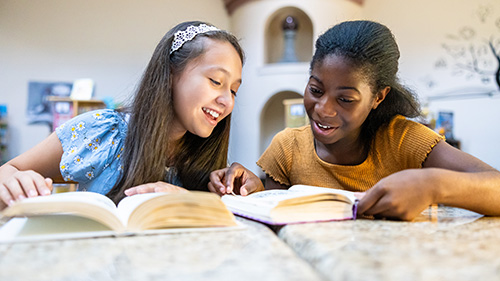ELA Skills Depend on the Development of Cognitive Processes
The goals of ELA instruction in middle and high school range from developing basic reading comprehension and writing skills to reading and writing...
AP & Honors Mathematics
Explore Wiley titles to support both AP and Honors mathematics instruction.
Literacy Skills & Intensive Reading
Connections: Reading – Grades 6–12
Empower student success with a proven intensive reading program that develops strong reading skills in striving readers.
Drama, Speech & Debate
Basic Drama Projects 10th Edition
Build students’ confidence and competence with comprehensive, project-based theatre instruction.
Literature
Connections: Literature
Support learners as they study dynamic, relevant texts and bring the richness of diverse voices to students through literature.
Literature & Thought
Develop critical thinking, reading, and writing across literacy themes, genres, historical eras, and current events.
Language Arts
Vocabu-Lit® – Grades 6–12
Help students build word power using high-quality contemporary and classic literature, nonfiction, essays, and more.
Connections: Writing & Language
Help students develop grammar, usage, mechanics, vocabulary, spelling, and writing and editing skills.
Reading/English Language Arts
Measuring Up to the English Language Arts Standards
Incorporate standards-driven teaching strategies to complement your ELA curriculum.
English Language Learners
Measuring Up for English Language Learners
Incorporate research-based best practices for ELLs with an approach that includes a focus on language acquisition strategies.
Mathematics
Measuring Up to the Mathematics Standards
Incorporate standards-driven teaching strategies to complement your mathematics curriculum.
Foundations
Measuring Up Foundations
Help students master foundational math skills that are critical for students to find academic success.
Science
Measuring Up to the Next Generation Science Standards
Give students comprehensive NGSS coverage while targeting instruction and providing rigorous standards practice.
Assessment
Measuring Up Live
Deliver innovative assessment and practice technology designed to offer data-driven instructional support.
For a better website experience, please confirm you are in:

Ask a teenager how they feel about reading, and you’ll likely get an eye roll, a groan, or a halfhearted, “I don’t like books.”
But let’s be clear: the problem isn’t reading. The problem is school. More specifically, the problem is the way schools teach reading—by force-feeding students a tired, outdated list of books they don’t care about and then dissecting them to death.
For years, many English teachers have operated under the belief that students must read certain books because they are “important.” Romeo and Juliet, The Scarlet Letter, A Tale of Two Cities, Lord of the Flies, and To Kill a Mockingbird are just a few examples of sacred texts that many schools refuse to move on from. And while some of these books may hold literary merit, let’s be honest: some do absolutely nothing to foster a love of reading in the average 14-year-old.
The issue isn’t just which books are assigned—it’s the very idea that students have no choice. Imagine if adults were told they could only watch a specific list of “culturally significant” black-and-white movies and that anything else was unworthy. Most people wouldn’t suddenly develop a passion for classic cinema; they’d stop watching movies altogether. That’s exactly what happens to kids in school.
Imagine if adults were told they could only watch a specific list of “culturally significant” black-and-white movies and that anything else was unworthy. Most people wouldn’t suddenly develop a passion for classic cinema; they’d stop watching movies altogether. That’s exactly what happens to kids in school.
When students are forced to read books they find boring, inaccessible, or irrelevant, they learn to associate reading with frustration and drudgery. Instead of seeing books as sources of knowledge, entertainment, or escape, they see them as work—something to be endured.
And then there’s the way these books are taught. Schools have a special talent for draining the life out of even a decent novel. Instead of letting students experience a book naturally, they break it into tiny, joyless pieces: vocabulary lists, comprehension questions, forced discussions about symbolism, and rigid five-paragraph essays. There is no room for curiosity, no space for personal connections—just an endless series of assignments designed to make sure students “get it.”
Kelly Gallagher, author of Readicide, describes this as “the systematic killing of the love of reading, often exacerbated by the inane, mind-numbing practices found in schools.” He argues that English classes are so focused on analyzing books that they forget to let students actually read them. Worse, schools send the message that reading “fun” books—mysteries, fantasy, graphic novels—is somehow less valuable than trudging through a 300-page novel written in 19th-century English.
If the goal is to create lifelong readers, then forcing kids to slog through outdated books isn’t just ineffective—it’s counterproductive. Research consistently shows that students who have a choice in their reading develop stronger literacy skills, read more frequently, and, most importantly, actually enjoy it.
This doesn’t mean schools should abandon all structure. Teachers can still introduce students to a variety of genres, authors, and perspectives. But instead of shoving the same “classics” down their throats year after year, why not offer a range of books and let students choose?
Some educators are already doing this. Teachers like Donalyn Miller (The Book Whisperer) have shown that when students are trusted to pick their own books, they read more—and they read better. Instead of seeing reading as a chore, they start to see it as something enjoyable, even necessary.
It’s time to face reality: the way schools teach reading is broken. If we want young people to love books, we have to stop making reading a miserable experience. That means moving away from rigid, outdated curriculums, giving students real choices, and, most importantly, trusting them to find books they actually want to read. Otherwise, we’re just setting them up to hate reading forever.

The goals of ELA instruction in middle and high school range from developing basic reading comprehension and writing skills to reading and writing...
.jpg)
While most early literacy development occurs in elementary school, teachers in middle and high schools continue shaping students' reading abilities,...

When the calendar gets crowded with winter concerts, makeup quizzes, assemblies, and general mid-year chaos, the idea of doing a full close-reading...

If you've ever worked with students who struggle with reading—or experienced that struggle yourself—you’ve likely seen it firsthand: the hesitation,...

In this activity, each student will create a "dating profile" for a book. By highlighting key characteristics of the book, students will craft...

Last week during her first week of school, I had a conversation with a fresh-out-of-college-first-year teacher who was spending her evenings typing...

One of the key shifts in English Language Arts classrooms is the move for students to engage routinely with complex text. To prepare students for the...

This webinar with Dr. Brandon Abdon, author of our AP Language and Composition and AP Literature and Composition AMSCO coursebooks, and guest ELA...

Every ELA teacher knows how to do this, right? Not exactly. This webinar invites all ELA teachers for an in-depth examination of the art of close...

Students' favorite streaming services, movies, and video games are all packed with compelling storytelling. To get them more excited about reading, I...

Transitional literacy focuses on bridging the gap between basic reading skills and more advanced literacy skills necessary for success during middle...

The best part of being an ELA teacher is getting to expose students to a diverse set of stories. To appreciate the new cultures and heritages more...
